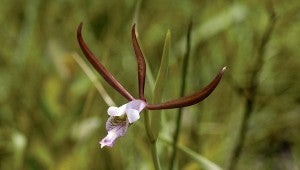Arboretum Paths: Month of May brings glorious native orchids
Published 7:00 am Wednesday, May 21, 2014

ORCHIDS ARE ABUNDANT: Cleistes bifaria, rosebud orchid, usually blooms in May in the Arboretum’s Savanna Exhibit.
Photo by, www.SoutheasternFlora.com
Patricia Drackett
Director, Crosby Arboretum/ MSU Extension
Even though the past few months have already brought us some phenomenal blooms on our local flora, the month of May really delivers the “icing on the cake”. We’ve already witnessed a variety of outstandingly beautiful native orchid species. The good news is that even those of you who claim to know nothing about plants can learn in a very short period of time how to identify these unusual flowers and their preferred habitats.
Yes, native orchids are out there, and many of them are waving at your car as you pass by. They are simply well-camouflaged by the emerging perennials and grasses along the roadsides. But if you know what to look for, you can spot some of these amazing beauties that are beginning to pop up throughout the county (Just be sure to apply your favorite chigger repellent if you decide to go stomping around in the grass)
Just the other day, Amy Nichols reported that she had discovered a rose bud orchid (Cleistes bifaria) in a road right-of-way. She’s one of those who knows what to look for. Last year, Amy and several other volunteers including Joy Lorens assisted Glen Ladnier of the Gulf Coast Orchid Society in planting over one hundred “rescued” orchids into our Savanna Exhibit.
According to Glen, most of Mississippi’s native orchids are ground orchids. Approximately 50 orchid species are native to Mississippi, and about 30 of them grow south of Hattiesburg and the Gulf of Mexico. Our three coastal counties have around 20 different native orchid species, with most of these found in the Jackson County area. One species is epiphytic (Epidendrum conopseum), meaning living in trees, and grows near water bodies as it prefers the higher humidity. The Arboretum also has an aquatic species – water spider orchid (Habenaria repens).
Other orchids seen in our exhibits include the rose Pogonia orchid (Pogonia ophioglossoides) or snakemouth orchid, found in such acidic, boggy sites, and the grass pink orchid (Calopogon tuberosus). Several different species of lady’s tresses orchid (Spiranthes spp.) are found in our pitcher plant bog.
Like people who cautiously guard found populations of ginseng or morel mushrooms, those who know where to find populations of native orchids are often reluctant to share this information. This is because they fear that people without the knowledge of how to grow these plants will want to rush right out to collect them, simply to say they have them. But attempting to transplant such species can have disastrous results as native orchids as a rule have very specific environmental conditions that they prefer.
Although your first impulse when spotting such unusually beautiful flowers such as these is to want to possess them, it is best to leave them where they are growing. Consider instead joining an organization such as the Gulf Coast Orchid Society (www.gcorchids.org), where you can get to know people who can provide solid tips on identifying and cultivating native orchid species, as well as which species are easiest to grow. Sometimes, native orchids will be available when sites are scheduled for construction and “rescues” are carried out prior to construction once permission is obtained from the landowners.
Mark your calendar, as this summer will bring a very special treat for orchid lovers. Dr. Wayne Morris from Troy University in Alabama will lead a field trip to Hillside Bog on August 2. Dr. Morris worked under Dr. Sidney McDaniel as a graduate student from Mississippi State University.
He has written extensively about, and photographed, native orchid species. He also plans to point out the other late summer blooming perennials on this field trip, and will be looking for emerging pine lilies (Lillium catesbaei).
An Arboretum botany walk will be conducted on May 31 by Dr. Mac Alford, Herbarium Curator and Associate Professor at the University of Southern Mississippi in Hattiesburg. To sign up for this program, call the Arboretum office at (601) 799-2311, or visit www.crosbyarboretum.msstate.edu.
FOR FURTHER EXPLORATION:
Visit www.southeasternflora.com and enter the keyword “orchid” in the common name search field to view many unusual native species. Then, go to the Crosby Arboretum home page and select the Native Plant Data Base to see what species are found at the Arboretum and to read more about them. If they are not in our holdings, you can still search the larger database on this www.wildflower.org website to learn more.


